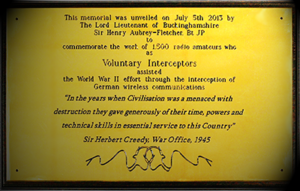The role of the RSGB and Voluntary Interceptors

Voluntary Interceptors memorial plaque at the NRC
History
At the outbreak of WWII in 1939 MI5 established a unit known as the Radio Security Service (RSS) to detect and monitor enemy radio transmissions.
With few resources to hand Lord Sandhurst approached Arthur Watts, President of Radio Society of Great Britain, who through the Society handpicked and recruited radio amateurs with advanced Morse skills.
These volunteers became known as the Voluntary Interceptors.
So vital and distinguished was the role of the RSS that it eventually became part of the overall Secret Intelligence Service (SIS).
In 2013 a memorial plaque was presented by The Lord Lieutenant of Buckinghamshire Sir Henry Aubrey-Fletcher to commemorate the work of the 1,500 radio amateurs as Voluntary Interceptors.
Operating from their homes, initially the role of the VI was to monitor for secret service agents, located in Britain, sending radio transmissions back to Germany. Later the VIs discovered and monitored the encrypted communications network of the Abwehr, the German Secret Intelligence Service.
Messages received, all coded, were copied on to log sheets and sent to P.O. Box 25, an address in Barnet, where they were sorted and then sent on to Bletchley Park for decryption.
This raw intercept material was unique in its nature and value, and was only provided by the VIs, it came from no other sources.
A fascinating insight to the role of the VI’s can be gained by watching this on-line video, originating from a BBC documentary.
Find out more
To find out more, visit the National Radio Centre (NRC) at Bletchley Park.
At the NRC there is an interactive presentation which contains the names of many VIs, describing their historic role, the equipment used and the resulting product—you will also find background information about the military Y stations and the Bletchley Park code breakers.
The trailer at the foot of the page gives an introduction to the exciting and wide-ranging content in the full interactive presentation.
A recent article by John Swartz in September 2018 RadCom provides an interesting insight to the work of the Voluntary Interceptors—you can download it here (2-page/183KB PDF).










